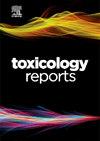Acute toxicological evaluation of bone-targeted parathyroid hormone-related peptide (PTHrP) antagonist to inhibit breast cancer metastases to bone
Q1 Environmental Science
引用次数: 0
Abstract
The present study evaluates the in vivo acute toxicological profile and drug distribution of a novel bone-targeted parathyroid hormone-related peptide (PTHrP) antagonist for bone metastatic breast cancer. [W2]PTH(1−33)-CBD was created by fusing PTHrP antagonist peptide to the bacterial collagen-binding domain (CBD) of ColG collagenase from Clostridium histolyticum to target the drug to type 1 collagen in bone. Acting as an inverse agonist at the PTH/PTHrP receptor, [W2]PTH(1−33)-CBD induced apoptosis in breast cancer cells and reduced tumor burden in mouse tibia. Female C57BL/6 mice were injected with vehicle, 320 µg/kg, or 1000 µg/kg [W2]PTH(1−33)-CBD as a single injection. Animal behavior, body weight, mortality, and biochemical and organ toxicity assays showed no significant changes during 28-day study period. [W2]PTH(1−33)-CBD distribution assessed by immunohistochemistry confirmed localization to bone, skin, and kidney. No significant changes in liver enzymes or serum protein were observed. Treatment reduced serum calcium and increased creatinine, but kidney histology showed no toxicity. Histological analysis of the kidneys showed no alterations, indicating no toxicity. Histological analysis of spleen, lungs, skin, and bone showed no pathological changes. Pharmacokinetic analysis was done after a single injection of 1000 µg/kg dose (via subcutaneous and intravenous) to female Sprague Dawley rats to determine how the body metabolizes [W2]PTH(1−33)-CBD. Serum was collected at various time points, and drug analysis was performed. Exposure from both routes was similar, indicating complete absorption of [W2]PTH(1−33)-CBD following SC. No clinically significant biochemical or histopathological changes were observed at these doses, thus establishing a safety profile for treatment with novel [W2]PTH(1−33)-CBD.
骨靶向甲状旁腺激素相关肽(PTHrP)拮抗剂抑制乳腺癌骨转移的急性毒理学评价
本研究评估了骨转移性乳腺癌的一种新型骨靶向甲状旁腺激素相关肽(PTHrP)拮抗剂的体内急性毒理学特征和药物分布。[W2]将PTHrP拮抗剂肽与溶组织梭菌ColG胶原酶的细菌胶原结合结构域(CBD)融合,制备PTH(1−33)-CBD,将药物靶向骨中的1型胶原。作为PTH/PTHrP受体的逆激动剂,[W2]PTH(1−33)-CBD诱导乳腺癌细胞凋亡,减轻小鼠胫骨肿瘤负荷。雌性C57BL/6小鼠分别单次注射320 µg/kg或1000 µg/kg [W2]PTH(1−33)-CBD。在28天的研究期间,动物行为、体重、死亡率、生化和器官毒性试验均未发生显著变化。[W2]免疫组化评估PTH(1−33)-CBD分布证实定位于骨、皮肤和肾脏。肝酶和血清蛋白未见明显变化。治疗降低了血钙,增加了肌酐,但肾脏组织学显示没有毒性。肾脏的组织学分析显示没有改变,表明没有毒性。脾、肺、皮肤、骨的组织学分析未见病理改变。雌性Sprague Dawley大鼠单次注射1000 µg/kg剂量(通过皮下和静脉注射)后,进行药代动力学分析,以确定身体如何代谢[W2]PTH(1−33)-CBD。采集各时间点血清,进行药物分析。两种途径的暴露相似,表明SC后[W2]PTH(1−33)-CBD完全吸收。在这些剂量下未观察到临床显著的生化或组织病理学变化,因此建立了新型[W2]PTH(1−33)-CBD治疗的安全性。
本文章由计算机程序翻译,如有差异,请以英文原文为准。
求助全文
约1分钟内获得全文
求助全文
来源期刊

Toxicology Reports
Environmental Science-Health, Toxicology and Mutagenesis
CiteScore
7.60
自引率
0.00%
发文量
228
审稿时长
11 weeks
 求助内容:
求助内容: 应助结果提醒方式:
应助结果提醒方式:


